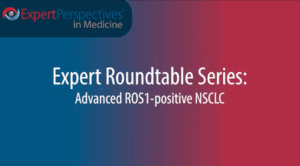Oncology
Advanced ROS1-positive NSCLC
Molecular Testing in Advanced Non–Small Cell Lung Cancer: Detecting Complex Rearrangements
DNA-based NGS can detect ROS1 translocations most of the time, but it may sometimes miss them. RNA-based tests are better for detecting certain translocations and can be much more sensitive. Many of the commercial platforms have expanded beyond DNA-based platforms to RNA-based platforms. A lot of commercial companies are doing very comprehensive DNA and RNA testing on tumor biopsy samples, and we usually get the results in 2 to 3 weeks. Circulating tumor DNA–based liquid biopsy assay results often come back within 1 to 1.5 week(s). Most liquid biopsies are DNA based, but research is bringing forward RNA-based liquid biopsies too.
<br>
Facilities that need to use the least expensive assays without RNA testing could potentially miss finding certain translocations. You have to think about the costs vs your real-time needs. ROS1 is not the highest on the list of probabilities, so you might do a polymerase chain reaction–based test to look for EGFR alterations, and you could get those results back within a couple of days. If that test is positive, you are done with testing; if it is negative, you have to perform additional testing. There are cases in which this approach is justifiable, but I am certainly not advocating for sequential testing because, 1 or 2 month(s) later, the patient still might not have received any treatment. I think that the standard of care should be to perform comprehensive NGS very early so that you can have those results back within 2 to 3 weeks.
<br>
In an ideal world, everybody with NSCLC would get comprehensive NGS, including RNA testing, up front. In the real world, I think that there can be some variations with that based on costs and other limitations. However, if you have a patient who has lung adenocarcinoma with no history of smoking cigarettes and you do not know the underlying molecular driver, you are not ready to start therapy until you have performed comprehensive DNA and RNA testing. And we must keep in mind that driver mutations may be present in any NSCLC, so, really, all patients should have their tumor tested.
<br>
If a driver mutation is identified, including ROS1, you would ideally start one of the novel TKIs, all of which have a very high response rate and a very long durability of response. However, there are exceptions, such as when a patient with NSCLC is too sick upon presentation or when there are problems with the testing, necessitating an earlier start to treatment. In these cases, it is worth knowing that pemetrexed-based platinum chemotherapy can also be highly effective with ROS1 and with some other driver mutations in NSCLC. I think that this is important for community practitioners and patients to know so that people do not think that it is a bad thing if they start chemotherapy. Another key factor is that if you are suspicious of a driver mutation being present because the patient has a limited or no smoking history, or is young, it is really better to avoid the use of ICIs until you are sure about the driver mutation status. ICIs do not work well against tumors with ROS1 or ALK, or many other driver mutations, and, once given, can increase the toxicity with future TKI use.
<br>
What should you do when a patient with NSCLC has been receiving a TKI for an ALK or ROS1 alteration and then it stops working? You want to try to figure out the resistance alteration. Sometimes you cannot, but there may be a mutation in the translocated protein, and this information may help you pick the next TKI.
Chen C, Douglas MP, Ragavan MV, Phillips KA, Jansen JP. Clinical validity and utility of circulating tumor DNA (ctDNA) testing in advanced non-small cell lung cancer (aNSCLC): a systematic literature review and meta-analysis. Mol Diagn Ther. 2024;28(5):525-536. doi:10.1007/s40291-024-00725-x
<br>
Desilets A, Repetto M, Yang SR, Drilon A. Targeting ROS1 rearrangements in non–small cell lung cancer: current insights and future directions. Cancer. 2025;131(suppl 1):e35784. doi:10.1002/cncr.35784
<br>
Gainor JF, Tseng D, Yoda S, et al. Patterns of metastatic spread and mechanisms of resistance to crizotinib in ROS1-positive non–small-cell lung cancer. JCO Precis Oncol. 2017;2017:PO.17.00063. doi:10.1200/PO.17.00063
<br>
Garinet S, Lupo A, Denize T, et al. Successive next-generation sequencing strategy for optimal fusion gene detection in non-small-cell lung cancer in clinical practice. Pathology. 2024;56(5):702-709. doi:10.1016/j.pathol.2024.02.014
<br>
Nesselbush MC, Luca BA, Jeon YJ, et al. An ultrasensitive method for detection of cell-free RNA. Nature. 2025;641(8063):759-768. doi:10.1038/s41586-025-08834-1
<br>
Robert NJ, Espirito JL, Chen L, et al. Biomarker testing and tissue journey among patients with metastatic non-small cell lung cancer receiving first-line therapy in the US Oncology Network. Lung Cancer. 2022;166:197-204. doi:10.1016/j.lungcan.2022.03.004
<br>
Roberts TJ, Kehl KL, Brooks GA, et al. Practice-level variation in molecular testing and use of targeted therapy for patients with non–small cell lung cancer and colorectal cancer. JAMA Netw Open. 2023;6(4):e2310809. doi:10.1001/jamanetworkopen.2023.10809
<br>
Tomasini P, Barlesi F, Mascaux C, Greillier L. Pemetrexed for advanced stage nonsquamous non-small cell lung cancer: latest evidence about its extended use and outcomes. Ther Adv Med Oncol. 2016;8(3):198-208. doi:10.1177/1758834016644155











